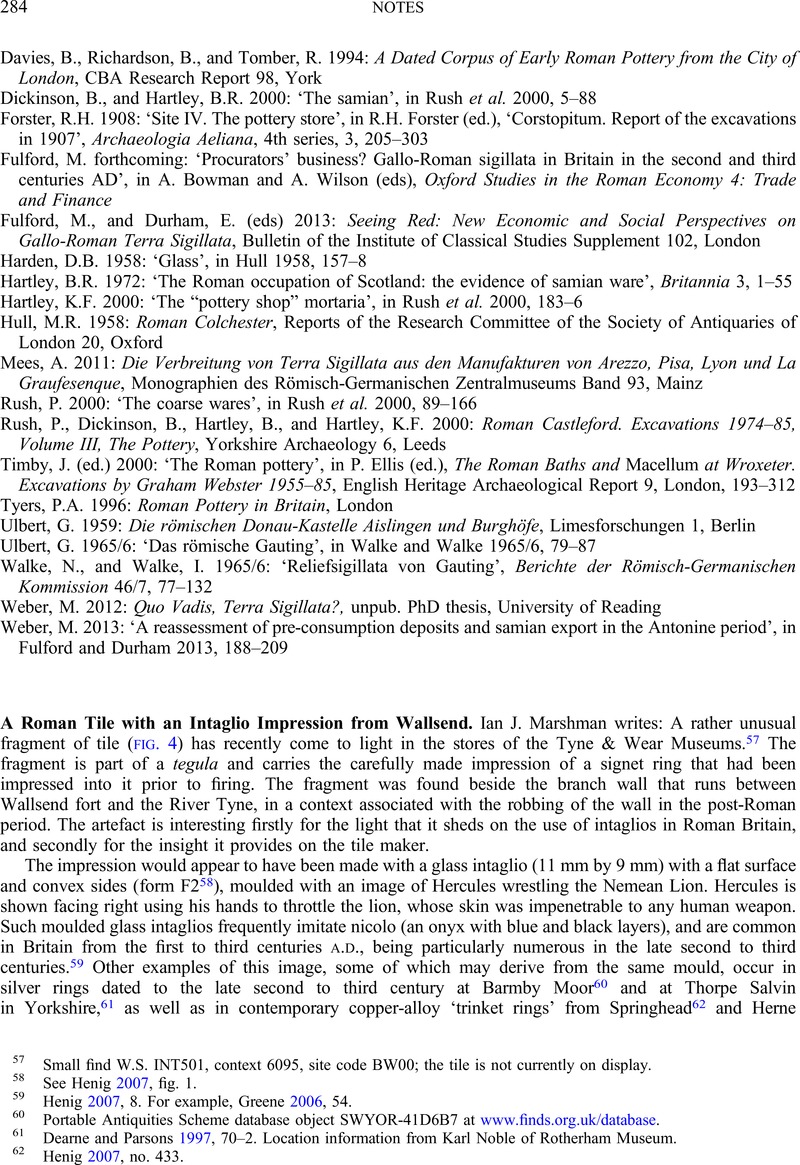No CrossRef data available.
Article contents
A Roman Tile with an Intaglio Impression from Wallsend
Published online by Cambridge University Press: 28 May 2014
Abstract
An abstract is not available for this content so a preview has been provided. Please use the Get access link above for information on how to access this content.

- Type
- Notes
- Information
- Copyright
- Copyright © The Author(s) 2014. Published by The Society for the Promotion of Roman Studies
References
BIBLIOGRAPHY
Barrett, A.A.
1978: ‘Knowledge of the literary classics in Roman Britain’, Britannia
9, 307–13CrossRefGoogle Scholar
Bushe-Fox, J.P.
1949: Fourth Report on the Excavations of the Roman Fort at Richborough, Kent, Reports of the Research Committee of the Society of Antiquaries of London 16, LondonCrossRefGoogle Scholar
Cunliffe, B.W.
1968: Fifth Report on the Excavation of the Roman Fort at Richborough, Kent, Reports of the Research Committee of the Society of Antiquaries of London 23, LondonCrossRefGoogle Scholar
Dearne, M.J., and Parsons, J.
1997: ‘Recent Romano-British metal detector finds in the Sheffield and Rotherham Museum collections and their relationship to rural settlement patterns in South Yorkshire’, Yorkshire Archaeological Journal
69, 39–92
Google Scholar
Fascády, A.R.
2007: ‘Ékszerlenyomatos Római Tégla Aquincumból’, Budapest Régiségei
40, 45–50
Google Scholar
Furger, A.R.
2009: ‘Fundsituation und Verbreitung der Siegelkapseln’, in Furger, A.R., Watermann, M. and Riha, E. (eds), Die römischen Siegelkapseln aus Augusta Raurica, Forschungen in Augst 44, Augst, 33–41Google Scholar
Greene, E.
2006: ‘The intaglios’, in B. Birley and E. Greene, The Roman Jewellery from Vindolanda: Beads, Intaglios, Finger Rings, Bracelets and Ear-rings, Vindolanda Research Reports, New Series, 4.5, GreenheadGoogle Scholar
Grimes, W.F.
1930: Holt, Denbighshire: The Works of the Twentieth Legion at Castle Lyons, Y Cymmrodor 41, London, 1–125
Google Scholar
Henig, M.
1970: ‘The veneration of heroes in the Roman army: the evidence of engraved gemstones’, Britannia
1, 249–65CrossRefGoogle Scholar
Henig, M.
1976: ‘A stamped sherd from Copthall Close’, Transactions of the London and Middlesex Archaeological Society
27, 239–41Google Scholar
Henig, M.
1977: ‘A bronze medallion and cube from Kingscote, Gloucestershire’, Antiquaries Journal
57, 319–21Google Scholar
Henig, M.
2007: A Corpus of Roman Engraved Gemstones from British Sites, BAR British Series 8 (3rd edn), OxfordCrossRefGoogle Scholar
Keegan, P.
2011: ‘Blogging Rome: graffiti as speech-act and cultural discourse’, in Baird, J.A. and Taylor, C. (eds), Ancient Graffiti in Context, London, 165–90Google Scholar
Konuk, K., and Arslan, M.
2000: Ancient Gems and Finger Rings from Asia Minor: The Yuksel Erimtan Collection, Ankara
Google Scholar
Lee, J.E.
1862: Isca Silurum: or, An Illustrated Catalogue of the Museum of Antiquities at Caerleon, London
Google Scholar
Marsden, A.
2009: ‘Roman intaglios and sealings from Norfolk’, Norfolk Archaeology
45, 529–38Google Scholar
McBride, R.M.
2003: ‘Tile’, in Hodgson, N. (ed.), The Roman Fort at Wallsend (Segedunum): Excavations in 1997–8, Tyne and Wear Museums Archaeological Monograph 2, Newcastle upon Tyne, 186–98Google Scholar
Mócsy, A.
1974: Pannonia and Upper Moesia: A History of the Middle Danube Provinces of the Roman Empire, London
Google Scholar
RIB II.6: Frere, S.S. and Tomlin, R.S.O., with contributions by Hassall, M.W.C.
1994: The Roman Inscriptions of Britain, II. Instrumentum Domesticum: Fasc. 6. Dipinti and Graffiti on Amphorae, Dipinti and Graffiti on Mortaria, Inscriptions in White Barbotine, Dipinti on Coarse Pottery, Samian Barbotine or Moulded Inscriptions, Stroud
Google Scholar
Strange, J.
1779: ‘An account of some remains of Roman and other antiquities in Monmouthshire. Addressed to the President, Council, and Fellows, of the Society of Antiquaries, by John Strange, Esq.’, Archaeologia
5, 33–80
CrossRefGoogle Scholar
Tomlin, R.S.O.
1979: ‘Graffiti on Roman bricks and tiles found in Britain’, in McWhirr, A. (ed.), Roman Brick and Tile: Studies in Manufacture, Distribution and Use in the Western Empire, BAR International Series 68, Oxford, 231–52Google Scholar
Tomlin, R.S.O.
1981: ‘Graffitic tiles’, in Lucas, J., ‘Tripontium, third interim report’, Birmingham and Warwickshire Archaeological Society Transactions
91, 31–6Google Scholar
Tomlin, R.S.O.
2011: ‘Writing and communication’, in Allason-Jones, L. (ed.), Artefacts in Roman Britain: Their Purpose and Use, Cambridge, 133–52Google Scholar
Webster, G.
1989: ‘Deities and religious scenes on Romano-British pottery’, Journal of Roman Pottery Studies
2, 1–28
Google Scholar
Webster, G., and Smith, L.
1982: ‘Excavations of a Romano-British rural establishment at Barnsley Park, Gloucestershire’, Transactions of the Bristol and Gloucestershire Archaeological Society
100, 65–189
Google Scholar
Wynia, S.L.
1969: ‘Ein Terra-Sigillata-Boden mit Gemmenstempel aus Vechten’, Berichten van de Rijksdienst voor het Oudheidkundig Bodemonderzoek
19, 279–82Google Scholar




